How To Decorate A Japanese Bedroom
The minimalistic Japanese theme is now gaining popularity and moving into the world of the bedroom. You must be wondering – why? Well, the Japanese style is highly sophisticated and simple. It focuses on "less is more" and thus allows one to transform their bedroom into a luxurious retreat.
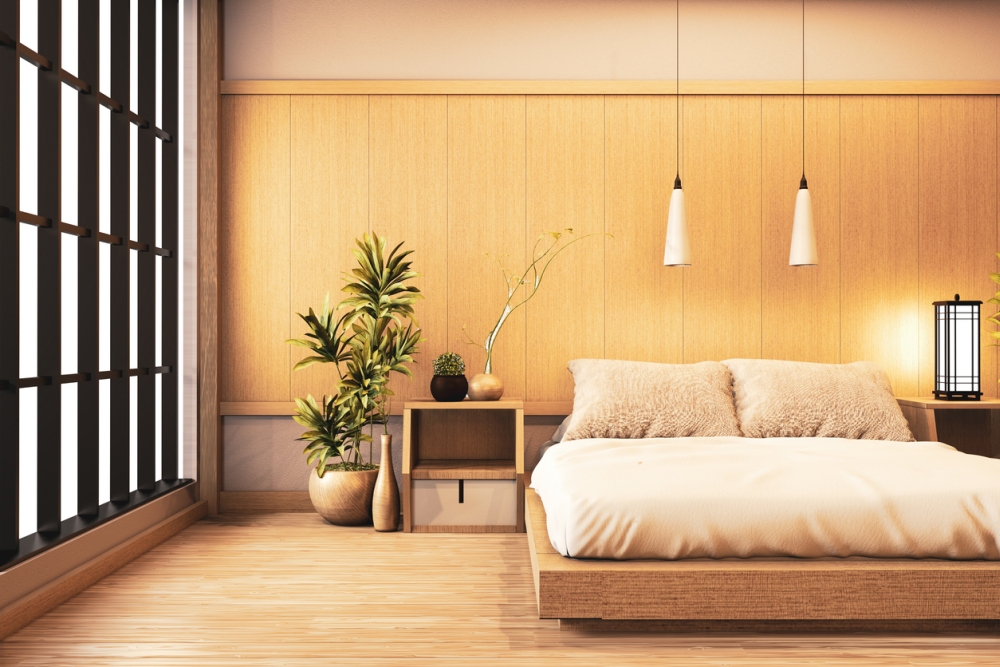
Check out some of these ideas to create your own Japanese bedroom you won't want to leave.
What Is Japanese Interior Design Called?
Not long before the turn of the twentieth century, there was a time when individuals believed that owning the most bizarre furniture made them appear abundant. However, as time passed and contemporary man came to understand the true meaning of elegance, he began to embrace minimalism in his lifestyle.
Zen is an interior design trend, but it's so much more than that: it's a philosophy. Zen is about man living in harmony with the world. Japan's culture is rooted in paying homage to historical traditions, instilling a sense of Zen, and living in peace with nature.
True to form, they incorporate as much greenery as possible into their design concepts. Additionally, you will notice an abundance of natural light and open spaces.
Japanese interior design places a premium on craftsmanship as well. Their stunning furniture designs are meticulously made in a dedicated design studio utilizing only natural materials.
Why Is Japanese Furniture so Low?
If you were to glance inside a Japanese household, the first thing that might come to mind is "sparse." This is because traditional Japanese dwellings, from ancient times to our days, lacked substantial seating and sleeping areas.
Without chairs or blankets, the Japanese typically sat and slept on the floor. This is because the Japanese value ma, or negative space, and aspire to simplicity. Objects would be spaced extremely widely apart, as the traditional Japanese felt that this created an environment conducive to creativity.
What Is Zen Interior Design?
Zen design embraces this minimalist ideology by incorporating natural materials, light and space patterns, and an almost monastic disdain of clutter. A Zen home is intended to be tranquil, meditative, visually balanced, and aesthetically pleasing. The concepts for structuring a life are equally applicable to home design.
Liberating the energy in a space entails removing any impediments. While you cannot demolish all of your walls, you can imagine your home as a clear stream of water. It feels like an open, unfettered habitat in which rooms dissolve into one another, doorways become nearly imperceptible passageways, and the eye is pushed forward into empty space.
Polish bare wood or slate floors when possible. Create your own cloud and let your imagination run wild. You'll need to remove more than just ostentatious lintels. You're going to have to part with a significant amount of your possessions.
Japanese vs. Scandinavian Interior Design
 View in gallery
View in gallery
At first, these two seem like completely different interior design trends, the situation is a bit more complex than that. Each aesthetic emphasizes simplicity, natural components, and comfort, so it's unsurprising that more and more designers are fusing the two styles and coining the term "Japandi".
Japandi is basically a hybrid trend that brings together Japanese and Scandinavian design elements and combines the best of both worlds so you don't have to choose between them. Combining Japanese interior design's sleek lines and pure minimalism with the warmth and coziness associated with Scandinavian aesthetics, Japandi is all about bringing simplicity and serenity into the house.
Japanese bedroom lovers that want to experience Japandi should know that this decor style is all about comfortable cushions, earthy tones, and minimal clutter.
What Is Feng Shui in Design?
 View in gallery
View in gallery
Feng shui has gained popularity in the American interior design market during the last 30 years, yet it has its origins in ancient China. Ancient cultures designed burial grounds to align with astronomical phenomena like stars.
Throughout history, practitioners improved the theory, pushing it into urban planning and finally into the home. The name feng shui comes from an old poem on the interconnection between human existence and the environment.
While feng shui principles apply to many aspects of life, they are most widely used in interior design since the tools are most simply used in a home.
Feng shui principles can be utilized to build and construct settings that allow you to flow, bloom, and awaken. Feng shui, like meditation, is about building environmental awareness. Feng shui urges you to slow down and notice the small nuances in your life and surroundings.
Tips for Adding Japanese Style to Your Bedroom
If you're going for a Japanese bedroom decor, here are some tips on how to nail the style.
Keep it minimal
 View in gallery
View in gallery
A Japanese bedroom is similar to a Western one in terms of function. The true distinction is seen in the layouts, furnishings, and general mood. This is what sets the average Japanese bedroom apart from the rest.
However, the most critical element of all revolves around a single concept: minimalism. Rather than accessories and arrangements, everything is based on minimalist principles, with an emphasis on functionality and simplicity. Anything deemed 'excessive' is immediately erased.
Choose low Japanese furniture
 View in gallery
View in gallery
As is the case with decorations, the same holds true for furnishings. One will notice that the traditional Japanese bedroom is devoid of heavy furnishings. In its place, a functioning bedroom is discovered, with minimal decor.
One of the most basic and unique characteristics of traditional Japanese furniture is how low it is to the floor. In traditional Japanese households, the typical chair is quite low to the floor and occasionally lacks legs entirely.
Typically, the space between the ceiling and the floor is only a few inches. This is usual in the majority of traditional Japanese dwellings.
Although this habit of practically sitting on the floor may be unfamiliar to many Westerners, sitting on the floor has been a long-standing tradition in Japan for thousands of years and was a respected tradition during Japan's high nobility period.
Allow natural light
 View in gallery
View in gallery
Natural light floods these residences, bringing with it tranquil views and natural hues. Large, panoramic windows and skylights are the ideal approach to incorporate this bright design into a Japanese bedroom.
Draperies that are too heavy are likewise a no-no. They do little more than obstruct this natural light. If this is not possible, opt for basic bamboo shades. Natural light is an excellent way to illuminate your home!
Go with simple colors
 View in gallery
View in gallery
Don't forget to incorporate plenty of greenery with natural houseplants. When selecting a color palette, simplicity is critical. Consider what natural color components you can include into your home now by looking out your windows.
Most colors specific to a Japanese bedroom are derived from brown wooden elements and green coming from plants, floors are often gray stone tile or wood, and walls are covered in opaque paper.
Top Tips for Applying the Minimalist Japanese Theme to Your Bedroom
1. Start with the Floor and Work Upwards
 View in gallery
View in gallery
The right way to design the bedroom is to start with the floors and slowly work upwards. For covering the floor, consider tatami mats. Tatami mat is a traditional material used in Japanese homes to cover the floor. The traditional tatami mats are made of rice straw and are highly comfortable for bare feet. In addition, if you find covering the entire floor a cumbersome task then place a tatami mat on the floor. Place a big mat in front of the bed or in the seating area.
2. Decide on the Color Scheme for Your Bedroom
 View in gallery
View in gallery
Secondly, decide on a color scheme for the room. Traditionally, Japanese décor features neutral earthy tones. Colors you may consider are cream, brown, beige, and black. Select any of these colors to dress the walls of your bedroom. Bring in splashes of colors by using bright nature colors through accent pieces. Orange, blue, green, and red are common accent colors that can be incorporated through paintings, linens, and decorative accessories.
3. Start to Add Furniture to the Bedroom
 View in gallery
View in gallery
Thirdly, you need to furnish the room. The furniture pieces that are used in Japanese Culture are close to the floor and thus impart a centered feel. The bed you choose for your Japanese themed room must be as low as possible. You may also place the futon mattress directly on the floor. Complement the bed with a bamboo or a basic lacquered dresser. Keep in mind that furniture pieces that cater to the functional need are only introduced to the bedroom. So, please do not clutter the room and destroy the theme.
4. Add Accessories to Finish Off the Room
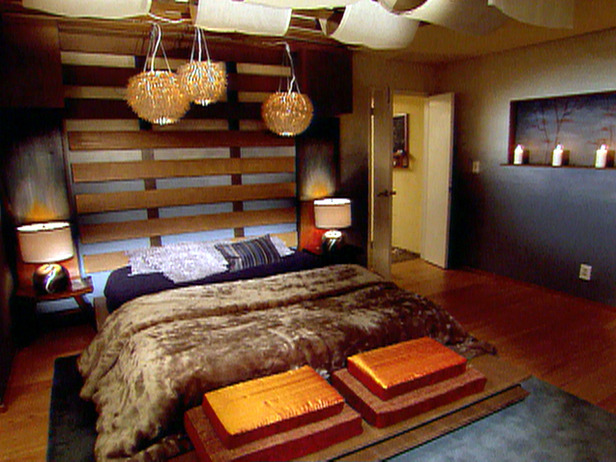 View in gallery
View in gallery
Also, you need to accessorize or decorate the room. Try to select the decorative elements in natural materials such as bamboo, rice paper, or wood. Enhance the bed or the benches or chairs of the room with silk pillows and cushions. You may hang silk curtains on the windows. Rice paper lanterns hanging from the ceiling also look good. For the walls, hang one or two Japanese art paintings, such as a cherry blossom or any other nature inspired piece of art work.
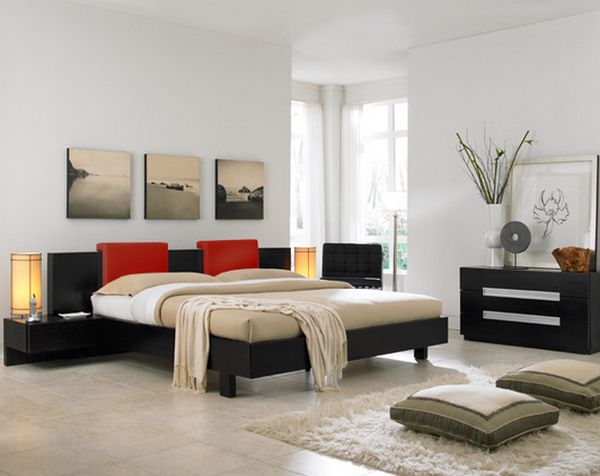 View in gallery
View in gallery
There are things you can borrow from Asian interior design when decorating every room of your home. In the case of the bedroom, these elements take the form of some specific pieces of furniture, accessories, materials, and finishes and we've going to explore some of the most popular and straightforward options.
5. Add a Low Bed
 View in gallery
View in gallery
Japanese furniture is usually low to the ground. In the case of the bedroom, this would best translate into a Japanese bed or one that has a suitable design. Platform beds often used in contemporary interior designs are excellent. {found on formaonline}.
6. Consider Textural Balance
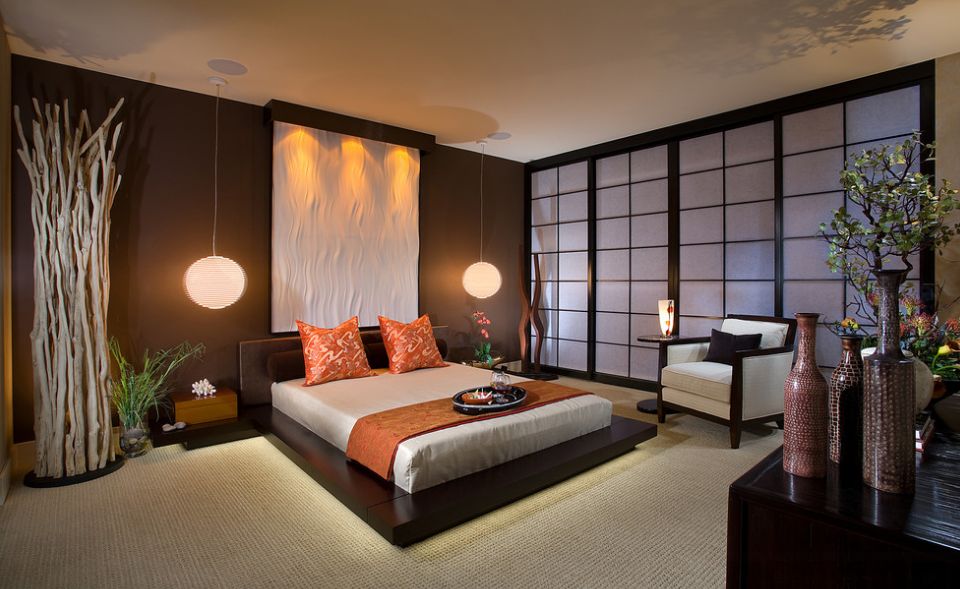 View in gallery
View in gallery
Balance is very important in Asian interior décor. Everything must be chosen carefully. The textures should work well together and they can be highlighted with accent lighting or using the right colors and color combinations. {found on icustomdesigns}.
7. Add Nature Inside the Room
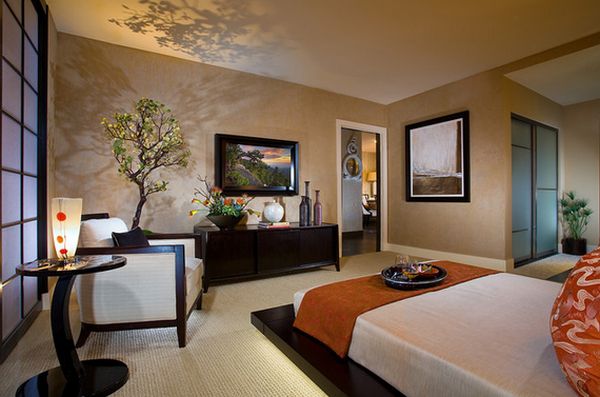 View in gallery
View in gallery
Another defining characteristic of Asian interior design is the beautiful connection between the interior spaces and the exterior and nature in particular. Bring some of that natural freshness and beauty inside the bedroom. Perhaps a bonsai tree would be just what the room needs.
8. Create an Open Space and Incorporate Natural Light
 View in gallery
View in gallery
keep the bedroom open and airy. It would definitely help if the room had large windows or glass walls. Natural light should inundate the room, making it look fresh, vibrant, and welcoming. To emphasize the openness of the space, simplify all the furniture as much as possible.
9. Use Natural Colors
 View in gallery
View in gallery
Extremely bold or neon colors are not something you see in Asian-inspired interiors or in bedrooms in general. So focus on natural colors, inspired by organic materials or by other elements found in nature such as stone, wood, or vegetation. {found on imidesignstudio}.
10. Add Sliding Doors or Screens
 View in gallery
View in gallery
Shoji screens are popular in Japanese interiors but they're not the only option you have when designing an Asian-inspired bedroom. There are also other types of sliding doors or screens you can use. These window coverings give the bedroom a rich and authentic look.
11. Place Handcrafted Art Pieces on Your Walls
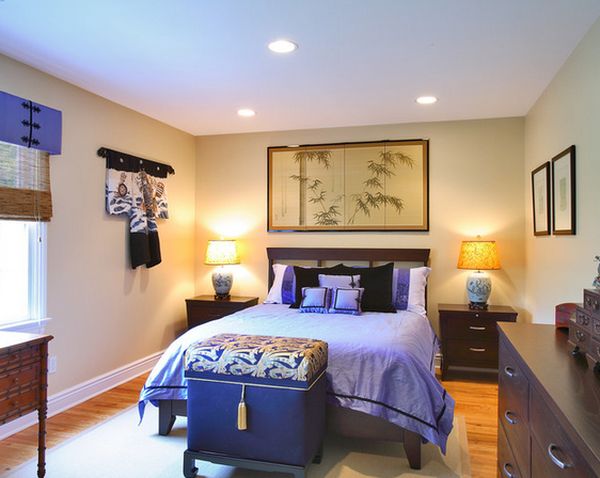 View in gallery
View in gallery
There are several options when decorating the walls of an Asian-inspired bedroom. One of them is to use something similar to this hand painted silk screen. It's simple but really lovely, with a theme that highlights the style chosen for the room.
12. Use Folding Screens for More Privacy
 View in gallery
View in gallery
If you need to separate your bedroom for more privacy, add traditional Japanese screens. We love this DIY idea from Instructables which will offer you privacy around your bed at night. It's a good idea if you don't have a large closet area but could also be used to block out sunlight when you are heading to bed. The great thing about this design is that you can make it fit any size of space, so you can add as few or as many panels as you need. There's quite a lot of woodwork involved in this project, but it will be a fun challenge for anyone looking to add a unique addition to their bedroom.
13. Add a Throw to Your Bed
 View in gallery
View in gallery
While we've primarily focused on the larger elements of the bedroom so far, when it comes to adding accessories, we love using a colorful throw. While this idea from City Zen Space features a very multi-colored design, you could go for a single color such as red or orange. While you've likely stuck with mainly neutral colors until this point, this adds a little splash of color and can create more personality in an otherwise quite plain room.
14. Embrace Minimalism With a Less is More Concept

You've probably already gathered by now, but Japanese bedrooms focus on creating space and minimizing clutter. Treehugger shares a great example of a tidy and bare Japanese bedroom, which has very few items and pieces of furniture in the room. If you are looking to create a calmer and more relaxing bedroom for after a busy day at work, you'll love returning to a room with very few belongings in. Follow Marie Kondo's popular methods for decluttering your space to bring more joy into your home.
15. Display Japanese Fans on the Bedroom Wall
 View in gallery
View in gallery
For a touch of Japan on your bedroom walls, we love adding Japanese fans. They barely cost anything to buy and yet will be ideal to use in your bedroom instead of artwork. You'll find Japanese fans that come in a wide range of colors, sizes, and materials, and all of these can be opened up to display their pattern or color, as shown here in this huge fan from Urban Outfitters. For a really minimalist room, opt for a single color, or find beautiful hand-painted designs to add more interest to your space.
Conclusion
As you can see, there are many different elements to consider when it comes to creating a Japanese bedroom. We recommend starting by decluttering your space and then plan out your bedroom using the ideas listed above.
Less is more when it comes to decorating in this style, and you'll find your new bedroom will be very relaxing to spend the night in. You'll discover that with fewer belongings around you, you can focus on what's really important and get the good night's sleep we all need in our busy lives.
How To Decorate A Japanese Bedroom
Source: https://www.homedit.com/how-to-make-your-own-japanese-bedroom/


Posting Komentar